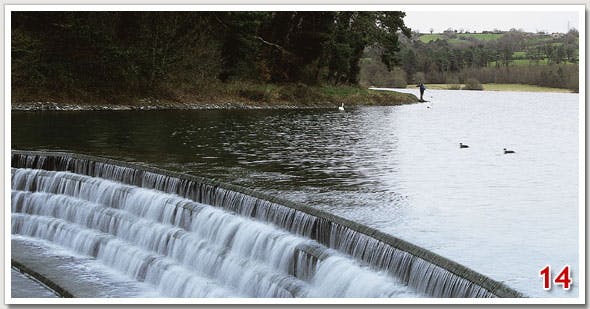STILLWATER AND RESERVOIR FLY FISHING GUIDE: BLAGDON LAKE
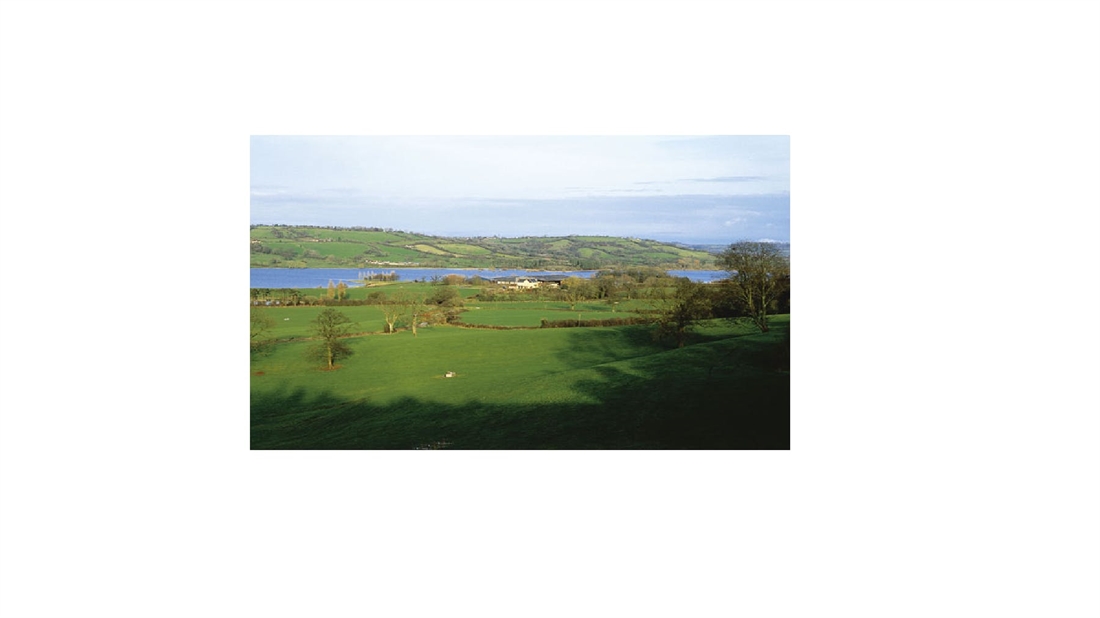
A WARM, still Summer’s evening, and the insects are hatching out on the water. A pint of locally-brewed ale to be quaffed outside a rustic West Country pub is calling but you can’t resist that last cast with a dry fly in the fading light. That’s the beauty of Blagdon which has been attracting flyfishermen to the Mendip Hills now for nearly 100 years. Bristol Water’s resident professional John Horsey is your guide round the bays and peninsulas of England’s most historic trout fishery.
OPENED in 1904, Blagdon Lake is one of our oldest reservoirs and commercial trout fisheries. Thousands of anglers make the annual pilgrimage from all around the world to fish its hallowed shores. The lake’s mock Tudor fishing lodge has changed little since those early days and records on the wall show the total annual catch returns during Blagdon’s illustrious history.
At 440 acres Blagdon is a comfortable size – large enough to be challenging, but small enough to get round easily in a day. There is a fleet of 20 rowing boats but, in my opinion, Blagdon is the best bank fishery I have ever fished. And I’ve held a season ticket to fish the bank for the past 18 years.
The array of bays, points and peninsulas gives the roving bank angler plenty of choice as the fish move constantly around the lake. Blagdon is a shallow lake with the average depth 13 feet at top water. This means that from the shore, you are never fishing over more than 10 feet, so floating lines can be used with total confidence from opening day right through the season.
There might be times when you will require an intermediate line to counter the effects of line drag during windy weather, or you will need to use a sinking line and Booby. But normally a floater will suffice.
There is no doubt that Blagdon Lake is a nymph fisher’s paradise. There are still huge hatches of buzzer and sedge throughout the season, and famous fly patterns such as the Amber Nymph, Buzzer Nymph and Grenadier were invented by Dr. Bell to imitate the naturals.
Nowadays, anglers are more likely to be using Diawl Bach Nymphs and Superglue Buzzers, but the style of fishing hasn’t changed much over the years. Dry flies such as Hoppers, Bob’s Bits, Carrot Flies and various Culs also score heavily throughout the season.
Blagdon is rightly famous for its evening rises. Less well known are the early-morning rises, which I can confirm are often far better than their evening counterparts. Those of us who have made the effort to get out of bed early are rarely disappointed. When I say early, I mean fishing at 3.30 during the Summer months – by 7.00am it is normally all over for the rest of the day!
All of Blagdon Lake is open and accessible for the roving bank angler except the dam wall, which is out of bounds. There is plenty of vehicular access to most banks, with car parking, toilets and fishing huts placed strategically around the lake.
There are also a few places where anglers can walk for a while to get away from the crowds and fish in splendid isolation. Blagdon is all things to all men.
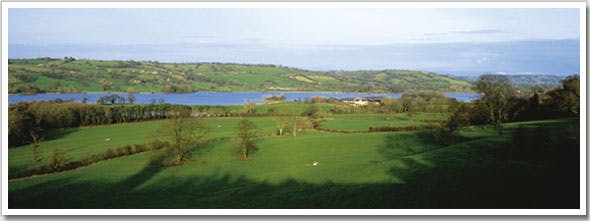
UNDERSTANDING THE WIND
WIND
DIRECTION
BEST AREAS
Trickiest
NW
Butcombe Shore
Prevailing
SW
Cheddar Water, Green Lawn, Rainbow Point, Wood Bay
Warmest
SE
Polish Water
Coldest
NE
Butcombe, North Shore, Ash Tree, Peg’s Point, Rugmoor
WIND DIRECTIONS
THE prevailing winds on Blagdon are South Westerlies. Due to the geological formation of the surrounding Mendip Hills, this wind tends to funnel down the middle of the lake from the Dam to the Top End. Righthanded anglers are best suited to the South Shore during a South Westerly, whereas left-handed casters can often have the North Shore to themselves!
The water can get a bit muddy on the North Shore in strong South Westerlies and the trout tend to sit in the clean water further from the shoreline.
Easterly winds are great on Blagdon – contrary to folklore! In fact, I prefer an Easterly wind to any other wind direction on both Chew and Blagdon. One thing is certain – the trout here love Easterly winds! This also opens up the whole of the North Shore plus Rugmoor Point and Rugmoor Bay for right handers such as myself.
A North Easterly wind can be cold and trout hate cold winds. There is little chance of surface activity during cold, windy weather and even less chance of a decent hatch. Once again, the North Shore is favourite during this direction, plus Butcombe Bay from the Island side.
I dislike both direct Southerlies and direct Northerlies. True, casting is much easier because the wind can be right off your back, but Blagdon trout tend to feed best when the winds blow parallel to the shores. Polish Water in front of the Lodge is great in a Southerly wind, but this area is only fishable during high water levels.
Rugmoor Point is a perfect spot during a Northerly wind, as you can cover fish as they pass the peninsula. However, the levels need to drop sufficiently to wade out here.
One important bit of advice regarding wind direction and theoretical fishing was taught to me through trial and error many years ago. “Fish where the winds blow directly into your face”. What rubbish! I too read the text-book theories of fish feeding right at your feet on food blown onto the lee shore. However, I can count on the fingers of one hand how many times this has, in fact, been the case!
As a contrast, I can sadly relate the tales of flies wrapping around my head, soaking wet trousers as the waves crashed over my waders and most important of all – dirty water!
No self-respecting trout will venture into the dirty water created by wave action on a lee shore, so my advice is: avoid these areas like the plague!
1) Cheddar Water
THERE is a culvert in this bay next to the Dam Wall where water is pumped in from Cheddar Reservoir – hence the name. It is a lovely bank spot, with manicured banks, fir trees and sheltered fishing in anything but a North wind.
There is ample room for at least six anglers and the banks drop off quickly into deeper water. The trout tend to patrol the margins of Cheddar Water during early morning and evening, but during the day they move out to the relative safety of the deeper water.
This water is easily within reach of the wading bank angler and during the Summer, the water in this area is usually pretty cool. It is easy to see the aerators in action at the Dam from Cheddar Water and during spells of hot weather, the trout are drawn here in large numbers. This colder water encourages the rainbows to continue feeding and the fishing here is generally very consistent.
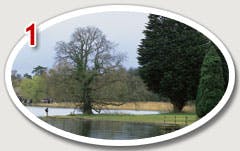
Around the corner towards the Lodge is Pipe Bay, which fishes best when the levels drop a few feet. The pipe itself brings fresh spring water into the lake from nearby Rickford and once again, the trout head into the Bay during hot weather.
TOP TIP: Good depth for fishing the ‘bung’ with buzzers below and fry feeders at the back end.
BEST TIMES: All year round.
WADING: Yes with care.
WIND EFFECT: Best on all but a Northerly wind.
2) Polish Water
YOU will not find Polish Water on any map of Blagdon. It is directly in front of the Lodge and best fished either at top water, or when the levels drop later in the season. Early season, the fish patrol along the margins of Polish Water, feeding on buzzer and bloodworm on the muddy bottom. You can sometimes have hundreds of quality browns and rainbows moving on the top here feeding on hatching buzzer, but they can be almost impossible to tempt.
There is a steeply shelving drop-off around 100 yards from the lodge and the trout always seem to hold in this area. When the levels fall drastically, it is possible to walk out to Polish Water and fish for the trout that cruise along the shelf.
TOP TIP: Trout rise here before they start moving anywhere else on the lake.
BEST TIMES: Early season at top level or back end when the lake drops substantially.
WADING? Only possible when the levels drop and with great care.
WIND EFFECT: Best in a South or South Westerly wind.
3) Green Lawns
THIS is probably the most heavily-fished bank on the Lake. You can drive to the area, park your car, get out and fish. Great for less mobile anglers and very popular with the older Blagdon regulars.
The majority of the trout for Blagdon are stocked from Green Lawns, yet few remain more than a few hours. The South Westerly winds tend to push the stockies down the lake toward Top End. This regular stocking does promote feeding from the more resident fish and this is probably one of the main reasons why Green Lawns is so consistent.
Wading along this shore is safe and the banks drop away very gently. At the Eastern end of the Lawns, there has been a considerable amount of close-season construction work. There is now a sound, reinforced bank with a new entry point for stocking into Holt Bay.
TOP TIP: Get as close to the Western Point as possible.
BEST TIMES: All season.
WADING? Good, firm bottom.
WIND EFFECT: Good in anything but Northerly winds.
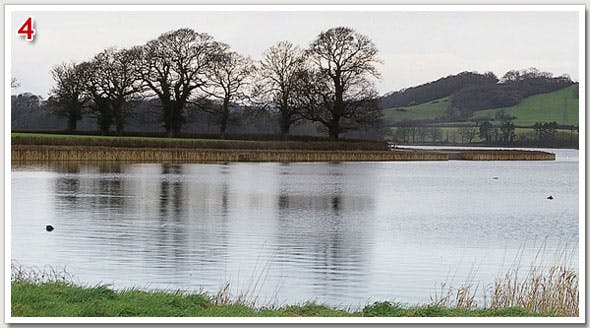
4) Holt Bay
NORMALLY, I would not advocate bank fishing in Holt Bay. There is a huge dairy farm alongside this Bay and the weed growth here can be phenomenal. However, due to the reinforcing work from Green Lawns through to Holt Bay, there is now a great-looking bank fishing area, complete with extensive weed scrapes and easy access for anglers.
If the new stocking ramp has the same effect on Holt Bay as it has had at Green Lawns over the years, Holt Bay could become a real hotspot.
TOP TIP: Gets heavily weeded during the Summer months, but the new weed scrapes might help this season.
BEST TIMES: Just after stocking!
WADING? Only possible after the levels drop a few feet.
WIND EFFECT: Best in a South-Westerly for shelter.
5) Rainbow Point
THIS is the most consistent point on the entire South Shore. Trout tend to pass across the Point and also swim alongside the banks. From opening day and right through the season, Rainbow Point will hold fish. It colours-up badly in a Northerly wind, but other than that, it is consistently good.
There are times during rapid weed growth when you will need to cast a long line to get over the weedbeds, but this is easily possible for competent casters, especially using shooting heads!
TOP TIP: A very popular spot, so try to get there early! Always consistent and normally not affected by Summer weed growth.
BEST TIMES: All year – right from Opening Day!
WADING? Good firm wading throughout.
WIND EFFECT: Fishable in just about all wind directions.
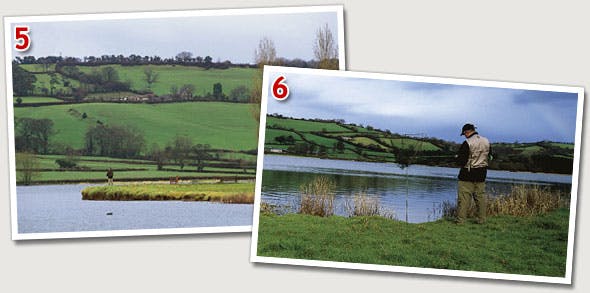
6) Wood Bay
THIS Bay is an enigma. One day it fishes its head off; the next day you can’t get a pull. I have never been able to work this one out. Early season when the lake is full, the sport here can be fantastic. However, heavy weed growth during the Summer months often makes fishing here an impossibility.
My favourite time to fish Wood Bay is at the end of the season when the levels drop and the trout move into the margins to feed on corixa. Often you can wade out ten yards into the slightly deeper water and the fish will move in behind you!
TOP TIP: Brilliant at the back end for corixa fishing.
BEST TIMES: Top level and the back end.
WADING? Take care when wading here as the bottom is very soft and treacherous.
WIND EFFECT: Best in West or East winds.
7) Bell’s Bush
NAMED after Dr. Bell, the fly fishing pioneer from nearby Wrington, Bell’s Bush is another area best suited to early or late season fishing. Shallow and muddy, the area is a haven for bloodworm, buzzers and corixa and floating fly lines are a pre-requisite.
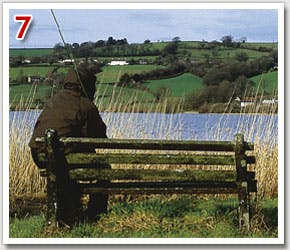
This part of Blagdon is known as the Top End and it contains masses of willow saplings extending from the shores into the water. These are known as the “withies” and the trout tend to stay away from their roots and branches.
When the levels drop sufficiently, there is a narrow peninsula extending into the lake below Bell’s Bush know locally as Wookey Point. This area is very shallow indeed, but at the end of the season, it can be well worth a try in an Easterly wind.
TOP TIP: Teams of buzzers and nymphs fished on floating lines.
BEST TIMES: Early season and back end.
WADING? Take care – soft and silty
WIND EFFECT: South Westerly definitely the best here.
8) Rugmoor Bay & Point
THE first Bay that you come to when entering the North Shore gates is Rugmoor. This is a fantastic area. The Bay is full of withies, bushes, reeds and sedge grasses and is the best area on the lake when the longhorn sedges are hatching. It can be alive during warm May evenings and the fishing is truly spectacular.
Rugmoor Point is covered with water at top level and can be accessed only when the water drops a couple of feet. From the moment the first brave wading anglers get out onto the Point, it rarely fails to produce fish. It is an area that can be fished in any wind direction and I think it is the best bank fishing spot on the whole of Blagdon.
You will have to park the car and walk to get out onto Rugmoor Point and I often fish it on my own at the beginning of the season. Fish always patrol the shoreline here and they also lie across the point itself.
TOP TIP: The Bay dries out during the Summer, but walk across to Rugmoor Point and you will have the most consistent area on the lake.
BEST TIMES: All season.
WADING? With care. Beware of pot holes.
WIND EFFECT: Good in all wind directions.
9) Peg’s Point
MY mum’s name was Peg and for this reason it was one of the first places I ever fished on Blagdon – I also caught four trout! It is without doubt the most popular place on the lake during the early season and you have to be a sociable type of person to fish here!
There is only room for about four anglers and the closer you can get to the point, the better!
There is a steep drop-off in front of the point, which holds the trout like bees to the proverbial honey pot. In a strong South or South Westerly wind, the water colours up badly, but in any other conditions, Peg’s Point is fishable in comfort.
During the middle of Summer when the water warms excessively, Peg’s Point can be alive during the early mornings, yet by an hour after sunrise, the fish are gone. During these sessions, it is possible to watch the trout move out of range as the sun creeps higher into the sky. So take my advice and get there early.
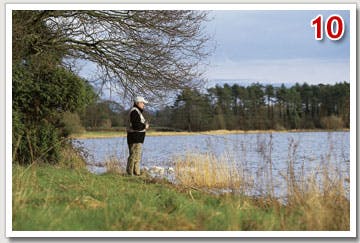
TOP TIP: All methods work here.
BEST TIMES: Early season until the levels fall.
WADING? With care – beware of the drop-off.
WIND EFFECT: Not good in a strong Southerly.
10) Ash Tree
THIS is another good bank area along Blagdon’s North Shore. However, as the bank drops off suddenly into deep water, careful wading is of paramount importance. Now we all know that trout love sudden drop-offs and undulating contours. They have it here in abundance. If the wind blows from the North or the East, this is where I normally fish.
Left-handed casters have a real advantage here as they can cast across the wind in the prevailing South Westerlies. I need to backcast to get across the wind and it is a method that I would recommend all right-handed casters to practise.
Along from Ash Tree is Orchard Bay. This is now getting too overgrown and deep to wade during the early season, but is a favourite haunt for the boat anglers. Once the levels drop a few feet, it is similar in features to Ash Tree and the fishing here can be excellent.
TOP TIP: Learn to back cast if you are right handed and want to fish here! Great evening rises if it’s warm.
BEST TIMES: All season.
WADING? Take care not to wade over the shelf.
WIND EFFECT Good in all winds, but Westerly best.
11) North Shore
THE North Shore is a long stretch of bank that contains lots of bays and points and is easy for the angler to access. The banks drop off quickly to water six to eight feet in depth and, once again, they all fish best in a West or East wind. It is best when the winds blow parallel to the banks, so that the trout cruise along the shoreline in search of food.
The top tactic is to cast a floating line across the wind and let a bow develop in the line.
Using a team of nymphs, this bow should be allowed to get bigger and “swing” the nymphs around and in front of the patrolling trout. When the takes come, they are often savage so it is crucial to use 8lb fluorocarbon or even stronger.
TOP TIP: Head for the points to cover patrolling fish.
BEST TIMES: All season.
WADING? Be wary of sudden drop-offs.
WIND EFFECT: Good in all winds except Southerlies.
12) North Shore Point
THIS is the last access point on the North Shore where you can drive and park a car. If you want to fish Butcombe Bay around the corner, you will have to “park and walk”. This area is also very popular and wading is not normally necessary – nor advisable due to the steep drop-off into deeper water.
Once the levels drop, you can wade. But you will need a sharp-pointed landing net handle to take with you as the bottom here is like concrete. As with most of the lake, there are decent buzzer hatches here, but sedges seem to prefer the hard bottom.
TOP TIP: This is one of the best places on the lake for Damsel Nymphs that seem to live along this shore.
BEST TIMES: All season.
WADING? No problems with wading here.
WIND EFFECT: Good in all winds – even Northerlies.
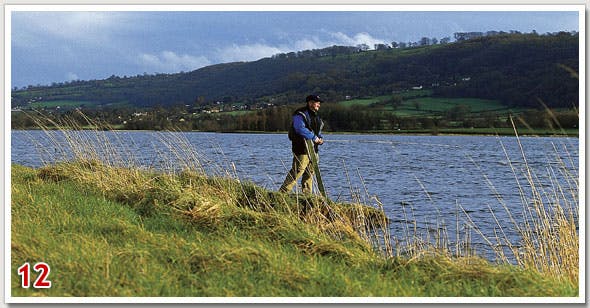
13) Butcombe Bay
ACROSS the Dam Wall from Cheddar Water is a lovely area called Butcombe Bay. Most of the Western shore of Butcombe has been reinforced with stone groynes and these provide very comfortable fishing.
The banks drop away quickly into eight feet of water and, although back casting is tricky due to the trees, it is not necessary to put out a long line to cover the fish.
At the bottom of the Bay, there is a small river which flows into the lake. This is a great spot during the early season. Across the Bay from the Dam side is the Island which provides a great vantage point in any wind direction. Early season it is one of the most popular spots on the lake, but watch out for nesting swans in the Spring and disturb them at your peril!
Along from the Island is All Saints Meadow which can be brilliant in most wind directions. The Bay here is unpredictable and very hard to fish when the weed starts to grow. Worth a cast or two though.
TOP TIP: Lots of caddis in this bay, so deep fished stick flies and Diawl Bachs work well on floating lines.
BEST TIMES: All season.
WADING? Careful wading required on the Eastern side.
WIND EFFECT: Always somewhere to fish in any wind.
14) Butcombe (Spillway)
ALTHOUGH the prevailing winds blow down the lake from the Dam Wall, they tend to turn the corner into Butcombe and blow straight down the entire Bay. Strange but true!
Butcombe is the only part of the lake where the public can walk along a footpath, so care must be taken when back-casting. The entire Bay provides good, sheltered fishing throughout the entire season. The lake bottom on the Western side of Butcombe is very hard clay, so there is never a huge growth of weed. This hard bottom is also a haven for caddis larvae and the fish often feed right in the margins along the shoreline.
On the corner of Butcombe nearest the spillway is a section of stone groynes, constructed to combat the inevitable bank erosion. This corner is not fished by many, but I personally rate it as a tremendous spot. Even when the wind is howling from the South West, there is always a bit of shelter here and it is one of the first places each evening where a hatch starts. As a consequence, fishing a dry fly on this point often works wonders. That concludes our journey round Blagdon Lake.
TOP TIP: Try a team of dries early evening as the winds start to drop. Always plenty of fly activity here.
BEST TIMES: At top water from the wall.
WADING? Not possible at all.
